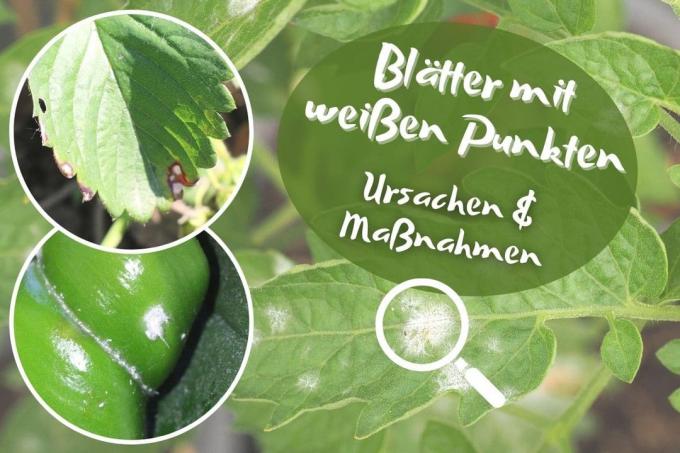
table of contents
- Failure to pour
- Diseases
- Pest infestation
- frequently asked Questions
Plants that flourish magnificently are a treat for the eyes and in some cases also a prerequisite for a good harvest. It is all the more worrying when white dots appear on the leaves.
In a nutshell
- small white spots on the leaves can have different causes
- there is usually nothing to worry about
- Damage can indicate care errors, diseases or pest infestation
- Recognize the cause as early as possible in order to be able to act effectively
Failure to pour
Small white spots on the leaves are often the result of incorrect watering. With the exception of marsh plants, the majority of all plants manage with relatively little water. They fear nothing more than too much moisture. The roots rot and can no longer supply the plants with nutrients. Have for example Succulents too much water stored in their leaves, they sweat it out, leaving white spots.
Countermeasures and Prevention
- Transplant affected plants into dry soil as quickly as possible
- do not water in the first few days after transplanting
- in future, carry out a finger test before every watering
- Let the upper layer of soil dry off
- Take into account the needs of the respective plant species
- use moisture meter if necessary
Tip: It is best to find out about their special requirements when buying plants.
Diseases
Powdery mildew (Erysiphaceae)
Powdery mildew can occasionally be behind such discolorations, for example in tomato or rosemary plants. At first there are small white dots or To see spots on the leaves that expand quickly and soon spread over the entire plant. They consist of a white, powdery fluff and occur mainly in warm and dry weather, hence the name "fair weather mushroom". Too much nitrogen in the soil can promote an infestation, because it weakens the defense of the plants.
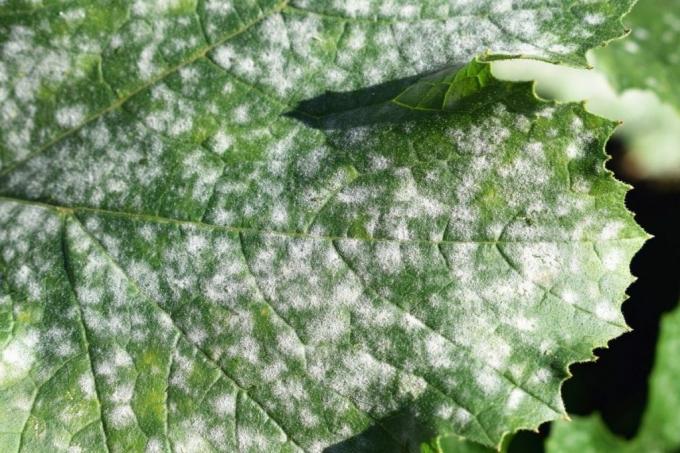
Combat
- Combat as early as possible
- in the case of initial infestation with self-made spray solutions
- from one part whole milk and eighth parts water
- Repeat treatment several times
- in case of advanced infestation remove affected leaves or shoots
- incinerate or dispose of with household waste
prevention
- Pay attention to loose, not too dense planting
- Use fertilizers, especially nitrogen, only in good doses
- Let the soil dry well before watering
- Pour only on the root area, not over leaves
- preventive injections with Vegetable sauces made from nettle or field horsetail
- increase the resistance of the plants
- Never dispose of infected seedlings on compost
Tip: When choosing or sowing plants, you should pay attention to resistant species and varieties.
White spot disease (Mycosphaerella fragariae)
White spots on leaves can also be an indication of the white spot disease, for example the strawberry. The spots have a red-brown border. The stronger the infestation, the more they run into each other. The associated reduction in leaf area damages the plants. The fungal spores overwinter on infected leaves and infect healthy leaves in spring. Here, too, too much nitrogen can promote an infestation.
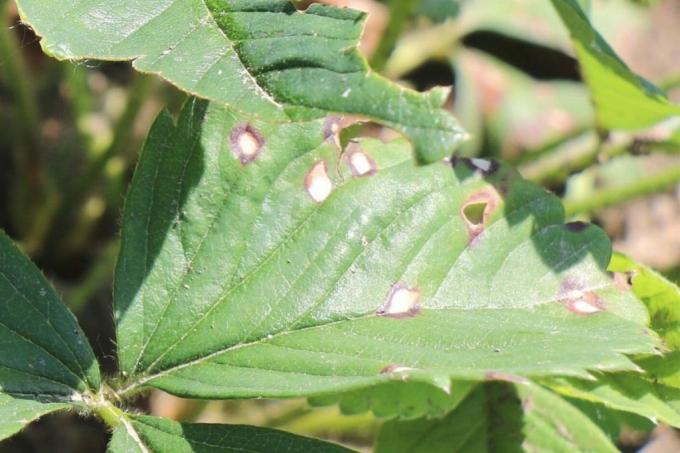
Combat / Prevent
- Control with a suitable fungicide
- Spray the leaves evenly with it
- remove particularly badly infested plants
- As a preventive measure, ensure that there is sufficient spacing between the plants
- This allows plants to dry out faster
- regular weed control makes sense
- do not fertilize too nitrogenous
Tip: Heavy rains can cause very heavy infestation.
White rust (Albugo candida)
This fungal disease can affect every known cruciferous vegetable. Root vegetables such as beets and horseradish are particularly affected. Symptomatic are white spots or Spots on the upper side of the leaves that become larger as the infestation progresses. Pustules later form. Affected leaf parts can sometimes be deformed and swollen.
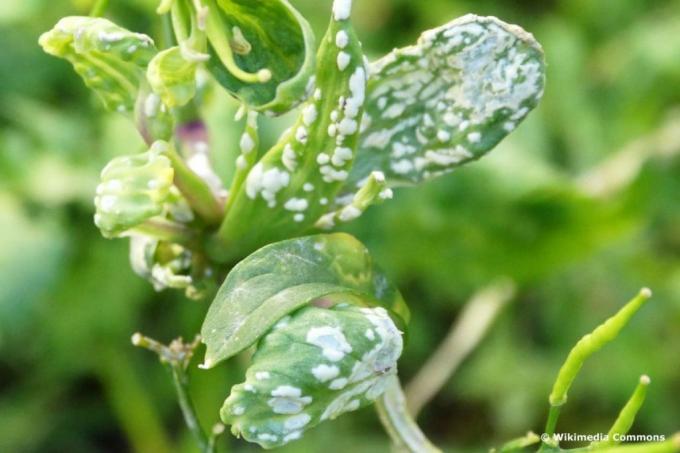
Source: Plant pests and diseases, Mustard white rust, Edited by Plantopedia, CC0 1.0
Combat
- only promising in the early stages
- remove all infected leaves and parts of plants
- including leaves lying on the ground
- Otherwise spores get into the soil
- Dispose of with household waste or burn
- Cut back into healthy wood
- Then disinfect cutting tools
- if necessary treat with a suitable fungicide
- if the infestation is very severe, dig up the plant and dispose of it
Tip: Damp and 13-18 degrees cool weather, caused by fog or persistent thaw, promotes an infestation. The spores can survive for many years in the soil, but also in seeds.
Pest infestation
Mealybugs (Pseudococcus)
The tiny pests covered by a white layer of wax can be seen as small white dots. They wear light-colored, cotton-wool-like threads. In addition to the leaves, they affect all parts of the plant. There is sticky honeydew on the leaves. The plant dies if left untreated. Drafts favor an infestation.
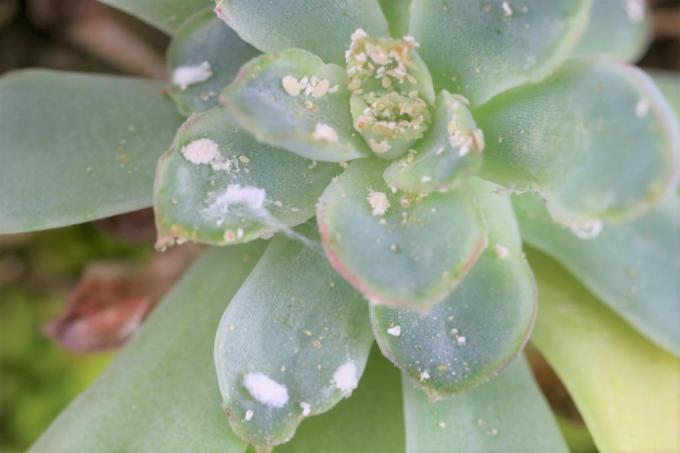
Combat / Prevent
- eliminate cause to combat
- So move to a draft-free location
- Use spray solutions that are easy to prepare
- from twelve grams of paraffin oil and one liter of water
- a good alternative is alcohol
- spray it over the pests
- Repeat the treatment several times
- chemical control only in the case of stubborn infestation
Tip: These pests do not make any special demands on the plants in order to infect them, which makes it difficult to find the cause.
Spider mites (tetranychus)
Through its sucking activity, the spider mite causes small white spots on the leaves. The leaves wither and wither. In addition, fine white webs can be seen that cover the infected parts of the plant.
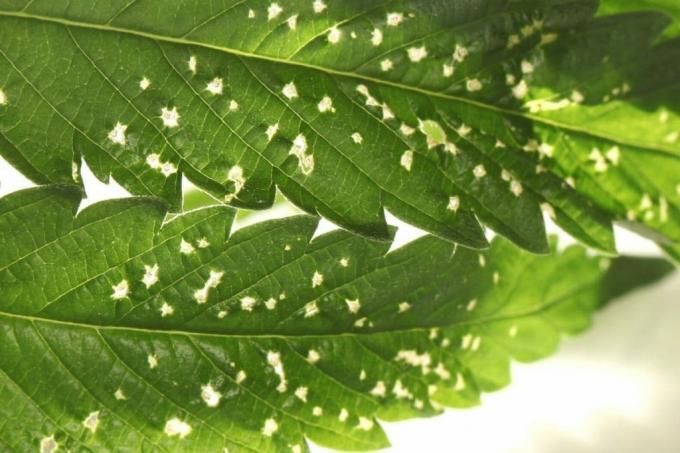
Control / Prevention
- ensure a moist environment
- vigorously rinse the affected plants
- Don't forget the underside of the leaves
- Put the translucent plastic bag over the entire plant
- finish on the ground with stones or the like
- Sack should be as airtight as possible
- leave for three days, then remove the sack
- repeat again if necessary
- Optimize site conditions
Woolly bowl louse (Pulvinaria regalis)
This pest occurs on trees and shrubs, especially maple, linden and horse chestnut. In spring, the ice sacs appear as five millimeter small white dots on the trunk and branches. On top of it the brown shields of the dead females who die shortly after laying their eggs.

Source: Donald Hobern from Copenhagen, Denmark, Pulvinaria regalis (7439920846), Edited by Plantopedia, CC BY 2.0
Combat / Prevent
- difficult with large trees
- Treat shrub-like plants with insecticide
- Remove any ice sacs that appear, ideally in spring
- by brushing or with a high-pressure cleaner
- preventive spreading of the pests
- Only transport cuttings covered
Rose leaf hoppers (Edwardsiana rosae)
An infestation occurs particularly frequently on climbing roses and in hot, dry weather. It first manifests itself in a fine whitish mottling of the leaves. Initially along the leaf veins and later on the whole leaf. If the infestation is severe, the leaves turn brown and fall off.
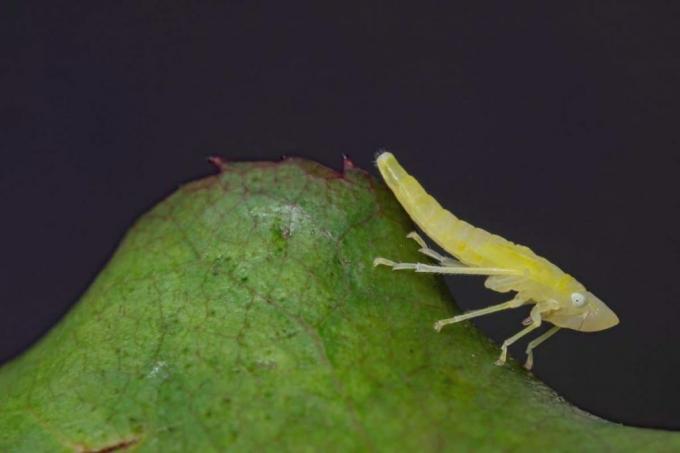
Combat / Prevent
- fight with light infestation with nettle stock
- use biological pesticides
- for example, neem-based preparations
- pay attention to a well-ventilated location as a preventive measure
- avoid sunny locations
- Regular pruning to remove overwintered eggs
- establish natural predators in the garden
frequently asked Questions
Powdery mildew occurs in warm and dry weather and first appears on the upper side of the leaves. Downy mildew requires high humidity and attacks the underside of the leaves.
Powdery mildew can occur again and again. One can only try to prevent it and ensure that it is disposed of correctly. It is best to look for resistance to powdery mildew when buying plants.
Even if it is not always easy, this is exactly the prerequisite for effective and effective control. Otherwise there is no effect and the infestation may be increased or increased. the plants additionally damaged.
